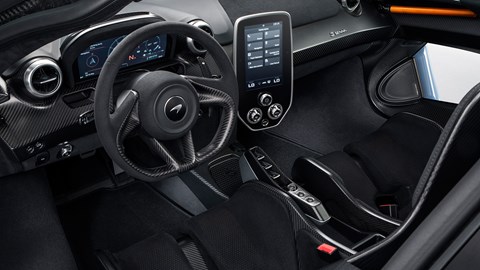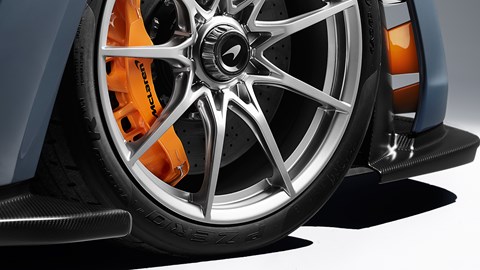► AKA P15 McLaren Ultimate Series car
► McLaren’s ‘most extreme road car yet’ gets even more extreme
► Brutal looks, extraordinary aerodynamics
For those who thought the McLaren Senna wasn’t striking enough, there’s now the Senna Carbon Theme edition. On paper, it’s almost identical to the ‘stock’ car. Statistically there is little change, as all P15 Sennas share the twin-turbocharged 4.0-litre V8, dual-clutch seven-speed transmission and 789bhp and 590lb ft outputs.
Instead, the change on the P15 Carbon lies within the bodywork – which costs a stout £250,000 extra.
How come? Boasting a new carbon body, the new Senna Carbon’s exterior is made over with 67 new parts which take the MSO tailors in Woking almost 1000 hours to produce. There are also yellow detailing and green brake calipers dotted around the car, in recognition of the Brazilian Formula 1 racing driver from whom the car takes its name.

The interior is given a similar makeover, with a carbon black theme, green door struts and a leather centre band on the steering wheel in that similar yellow tone.
McLaren has also taken this opportunity to produce a series of different steering wheel options. A Hybrid Carbon Fibre Wheel is the only alternative design available from McLaren for this car and is 10% lighter than standard, with a 10-15% reduction in rotating inertia, improving acceleration, braking and steering response, says Woking.
We’ll get an even better look at the new Carbon Senna at the 2018 Geneva motor show.

McLaren Automotive has already confirmed performance figures for its brutal new McLaren Senna road-legal track car.
It’ll get from 0-62mph in 2.8sec, which is impressive enough, but more startling is its 0-124mph time of 6.8sec. To reach 186mph from standstill takes only 17.5sec. And top speed is 211mph. Yes, this is a monstrously fast car, make no mistake.
McLaren Senna: the name
The most uncompromising road-legal release yet from the Woking-based car maker, the McLaren Senna is named after one of Formula One’s most legendary drivers. The smooth Brazilian drove for McLaren from 1988 to 1993, winning three championships before dying in a crash at Imola in 1994.
So how much has McLaren paid to license the Senna name? Nothing. Kind of… McLaren has a good relationship with the Senna family, including Ayrton’s nephew Bruno. There’s no direct payment to Senna’s heirs, but McLaren will make an undisclosed donation to the Senna Foundation charity for each of the 500 cars it sells – and all have already sold out.

McLaren Senna: where does it fit in?
The McLaren Senna replaces the P1 in some ways, but in other ways, it really doesn’t.
McLaren felt that the P1 was slightly compromised by its need to satisfy both road and track requirements, so it’s being replaced by two cars: the very track-biased Senna and a three-seat GT inspired by the legendary McLaren F1 and currently codenamed BP23.
We’ll see the 2+1 road-going hypercar later in 2018, and it’ll cost around £1.6m plus taxes.

The Senna will be capable of a quicker laptime around a track than a P1. McLaren’s Ultimate Series boss Andy Palmer assures us that although this car is road legal, that’s not what it was designed for.
Everything about the Senna was designed to help it tick off laps as quickly as possible.
McLaren Senna: engine and performance
Unlike many forthcoming high performance cars, the McLaren Senna won’t have any form of electrical assistance. There’s no hybrid powertrain, just a derivative of McLaren’s 4.0 twin-turbo V8 massaged to produce 789bhp and 590lb ft (a nice round and symmetrical 800ps and 800Nm in new money). The engine is claimed to be as much as 2kg lighter, with a redesigned air intake, inlet manifold and camshafts.
Power is down on the P1’s 903bhp, but this is a different sort of car. The P1 weighed 1395kg dry and the Senna weighs just 1198kg (dry – assume fluids add around 100kg, so reckon on approx. 1300kg). That makes for a 647bhp-per-tonne power to weight ratio for the P1 and 659bhp for the Senna.
The carbon front wings weigh just 650g each, compared to 2.2kg for the aluminium jobs on the 720S. One Senna door weighs 9.88kg; a 720S door weighs 19kg.
McLaren has even switched from using M6 to M5 fasteners, saving 33% per fixing.

The seats’ carbon shells weigh 3.3kg each (before cushioning is added, admittedly). They’re designed for the best possible airflow around the driver’s back – you can get very warm when you’re working hard on a track in race overalls – and they’re also available in a wider size for bigger people, euphemistically called ‘Touring’ width.
McLaren Senna: design and aero
The Senna uses the latest incarnation of McLaren’s hydraulic suspension system and that it features a new generation of carbon-ceramic brakes that run much cooler and require less disc surface area, thus saving weight.

Selecting Race Mode drops the ride height by 50mm, helping increase downforce by 40%.
Active aero features at the front and the back. By moving the transmission radiators from beneath the headlights to where the luggage space would normally be (a space behind the seats for helmets is your lot), McLaren has created two channels for airflow, each featuring a motorised flap.
The front splitter’s design is almost like a three-element wing. We wouldn’t recommend attempting any speed bumps in the Senna…

At the back, the huge – and stunning – rear wing switches angle automatically by up to 25 degrees to tailor the amount of downforce, reducing drag on the straights, shortening braking zones, and keeping balance in corners. It’s an interesting design, featuring the mounting points on the top surface to keep the important lower surface as clean as possible.
The body’s shaped like a teardrop, with four outboard pods for the wheels, pushed out into the airflow for maximum downforce.
The rear wing weighs just 4.9kg, but it alone contributes to 500kg of the Senna’s total 800kg downforce at 155mph. That’s 40% more than the McLaren P1, and the Senna is claimed to be capable of 30% more lateral grip. That’s a big jump.

Tyres are bespoke Pirelli Trofeos, wrapped around new centre-lock wheels. The brake discs are claimed to take seven months to manufacture. While the P1 could decelerate from 124mph to zero in 116 metres, the Senna is said to do the same in just 100m.
McLaren Senna: the interior
Not massively dissimilar to a 720S, though that funky glass panel in the door skin certainly gives the view out a different feel. In order to make it work McLaren had to bisect the upper section of door glass, which gives a nice visual nod to the McLaren F1.
If you don’t fancy other drivers being able to see your knees knocking when you creep back into the pits having just sacred yourself silly with its performance, you can swap the lower glass for carbon.
Other options include a stereo, and air-con. This is that type of car.

Predictably, there are acres of carbon everywhere inside, including on the gorgeous seats. One nice touch is that the RND gear selector buttons move with the seat when you slide it fore and aft.
Another is that the rear bulkhead is now integrated into the Monocage III carbon chassis structure (incorporating roll-over protection) and that seems to have enabled McLaren’s engineers to let the driver see far more of the engine than ever before when glancing in the rear-view mirror (unless they go for the optional full-height bulkhead).
To keep the dash uncluttered there’s a cluster of controls just above that mirror including the door release levers, the Start and Race buttons and even the electric window switches. Alfa 75, anyone?
McLaren Senna: the price
The Senna costs £750,000 plus local taxes, McLaren is building 500 of them, and they’re all sold.

The waiting list was said to be three times oversubscribed on the basis of one sketch. Nobody cancelled when they saw the car for real, and one car was deliberately left to be auctioned on the night of the unveil. The winning bid was £2.3m, essentially three times the list price, with proceeds going to the Ayrton Senna Institute.
If your name’s not down maybe you can grab one of the Track-only GTR versions coming later. Palmer reckons there’s another 50-80kg to come off the Senna’s kerb weight by ditching road bits like the lights.
Read all our McLaren car reviews
